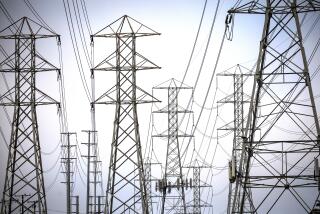Readers React: Why ‘cheap’ coal is actually expensive
- Share via
Before bemoaning the fact that we are moving from coal to renewable energy, it should be noted that coal-generated electricity is no bargain. The hidden cost of coal is $345 billion a year, according to Harvard researchers. Given that, coal is one of the most expensive fuels in the U.S.
We all suffer from climate change thanks in no small part to coal. In Appalachian mining communities, the public health effects include premature death, higher rates of lung and heart disease, and greater prevalence of childhood asthma.
Mountaintop removal impacts the groundwater, rivers and lakes in the area. Consequently, there’s a loss of tourist dollars to these areas.
The sticker price might be going up because of the shift from fossil fuels, but not the cumulative price. We can’t afford not to move to renewable energy.
Ann Sturman
Westlake Village
We should all look forward to the day when our energy needs are met by clean and renewable sources. The problem is, despite ill-planned legislative and regulatory mandates and massive taxpayer-funded grants and subsidies, such power sources are nowhere near as efficient or economical as fossil fuels.
Until the day when clean sources can meet our needs in a realistic manner, it is unwise to regulate fossil fuels out of existence.
Ron Lesovsky
Huntington Beach
This article refers to the “cheapest” energy (coal) and “expensive” power (renewable). It also stresses the “fragility” of the electrical system, which is dependent on centralized power plants and a vulnerable grid of supply lines.
These are the best possible arguments for expanding distributed electrical power in California. Our winters are mild in most densely populated areas, so electricity demand is lower when days are short. Our blackout threats come in the summer, when air conditioners run full blast — but when days are long and provide maximum solar energy.
The more we transfer energy production to individual rooftops via solar panels, the less fragile and vulnerable our electrical system becomes.
As for cost, who can calculate how much we’ve paid for “cheap” fossil-fuel-produced energy in dealing with rising oceans, toxic emissions and attendant health problems?
Ken Fermoyle
Woodland Hills
Like most other people, I do not welcome utility bill increases. But when this article states that our electricity bills will rise by 47% in 16 years, it should also point out that such an increase is less than 2.5% a year.
Paul A. Lord
Apple Valley
ALSO:
Did California drive Toyota to Texas?
More to Read
A cure for the common opinion
Get thought-provoking perspectives with our weekly newsletter.
You may occasionally receive promotional content from the Los Angeles Times.










